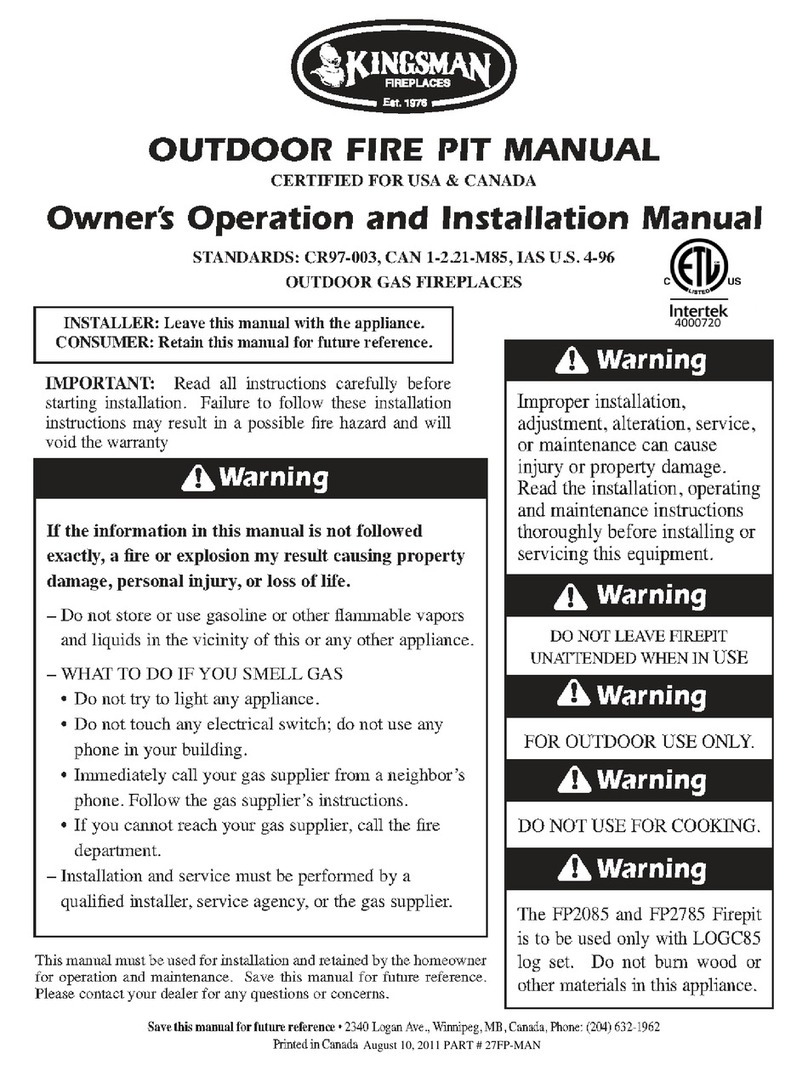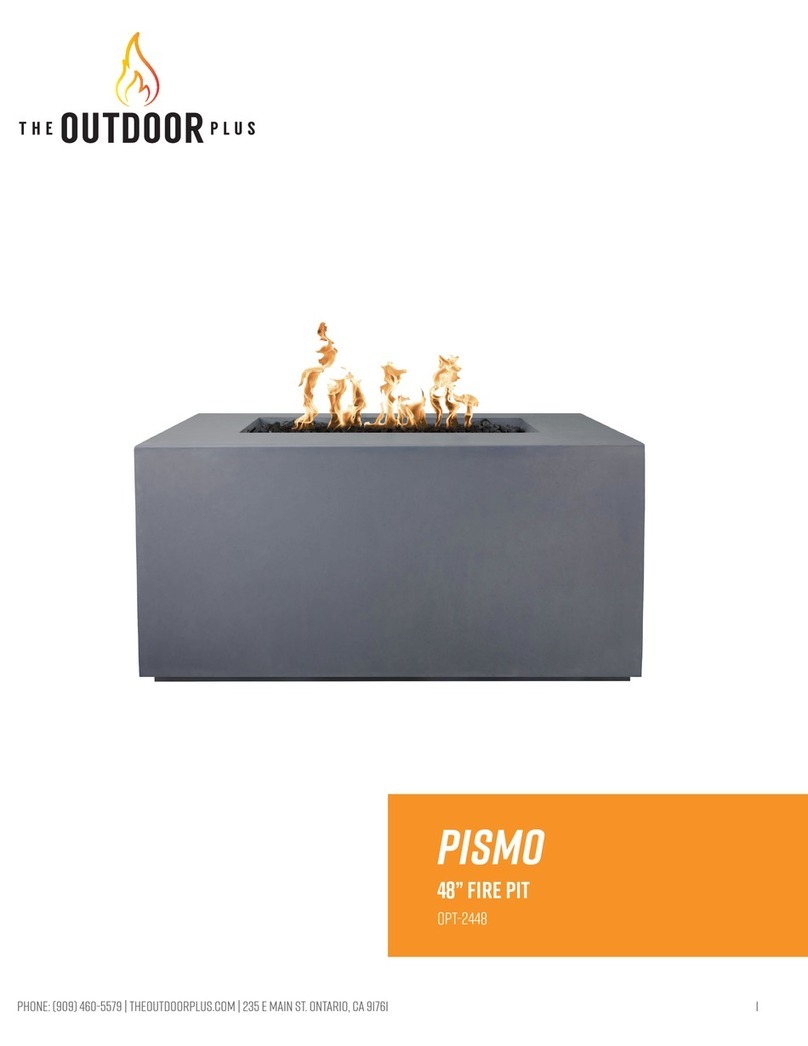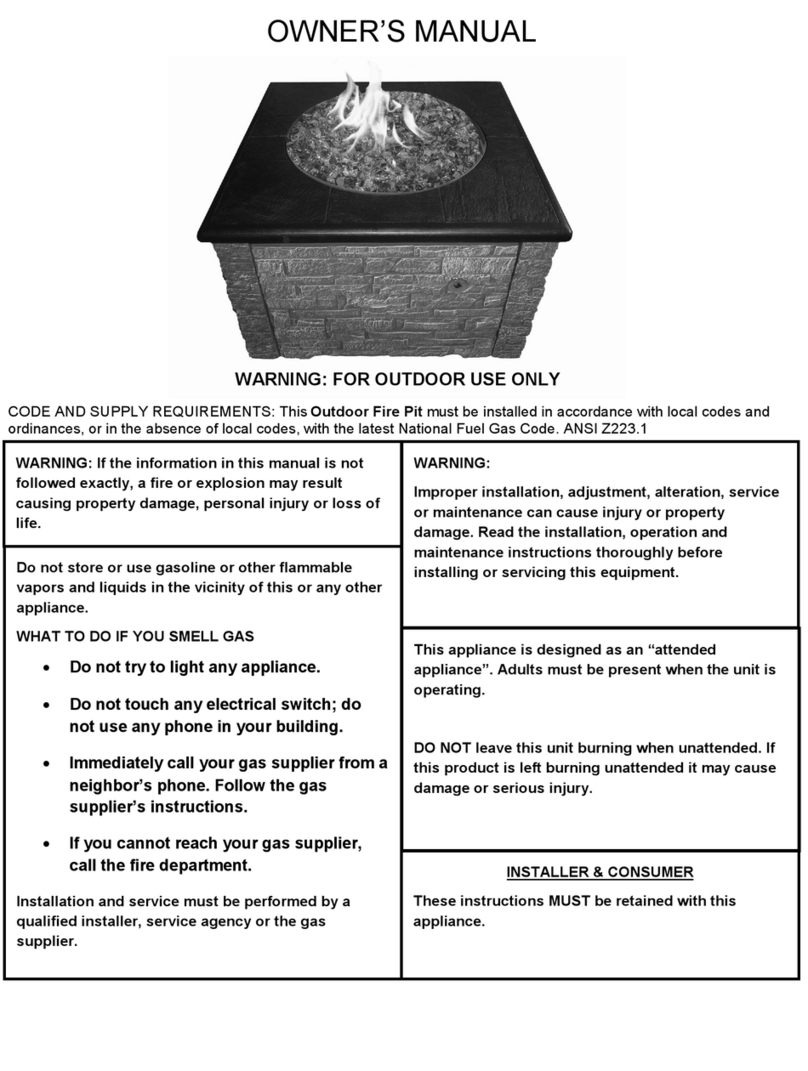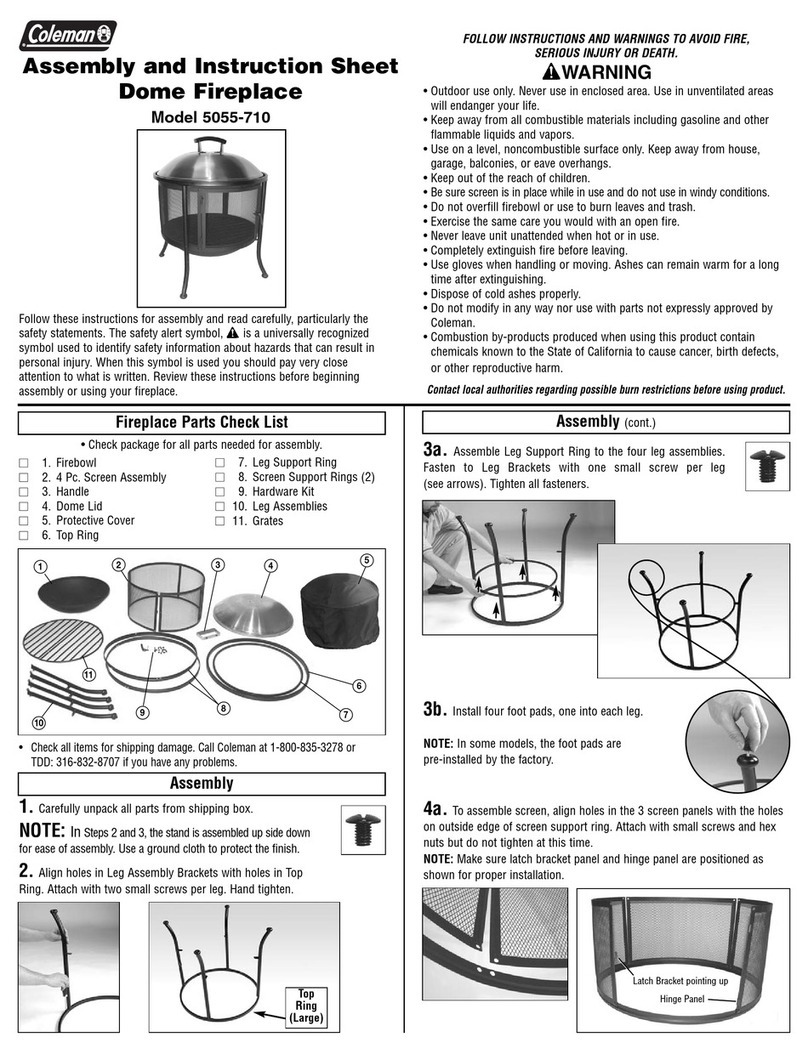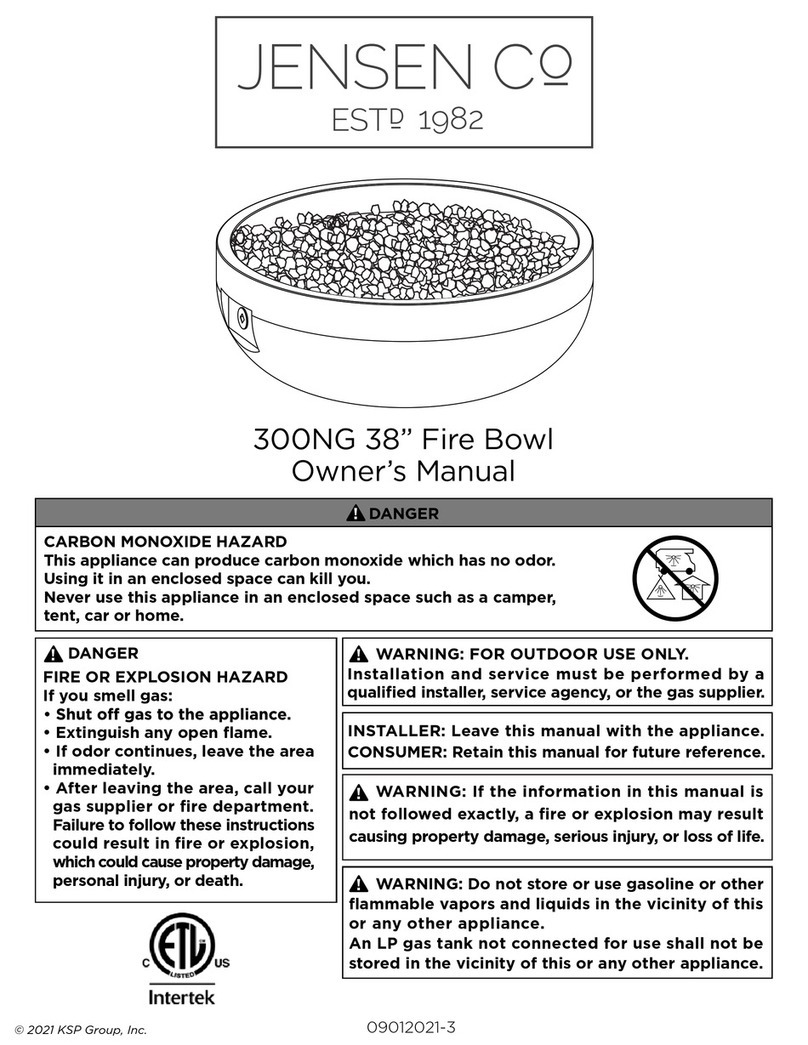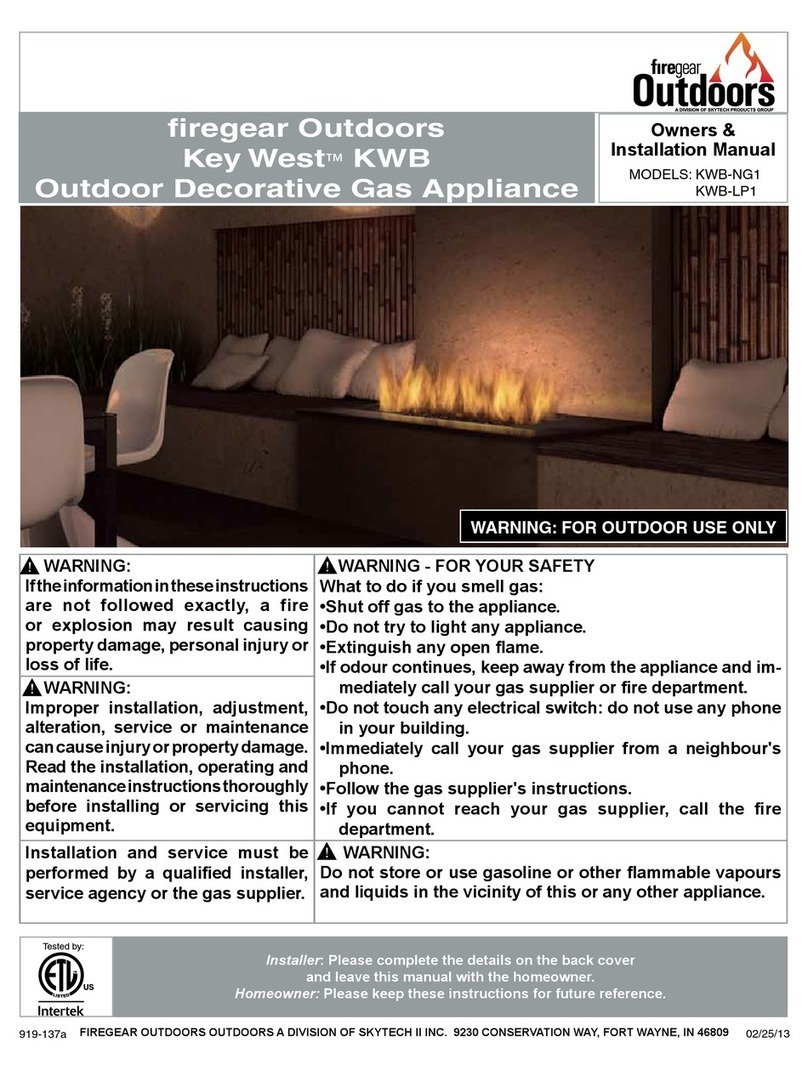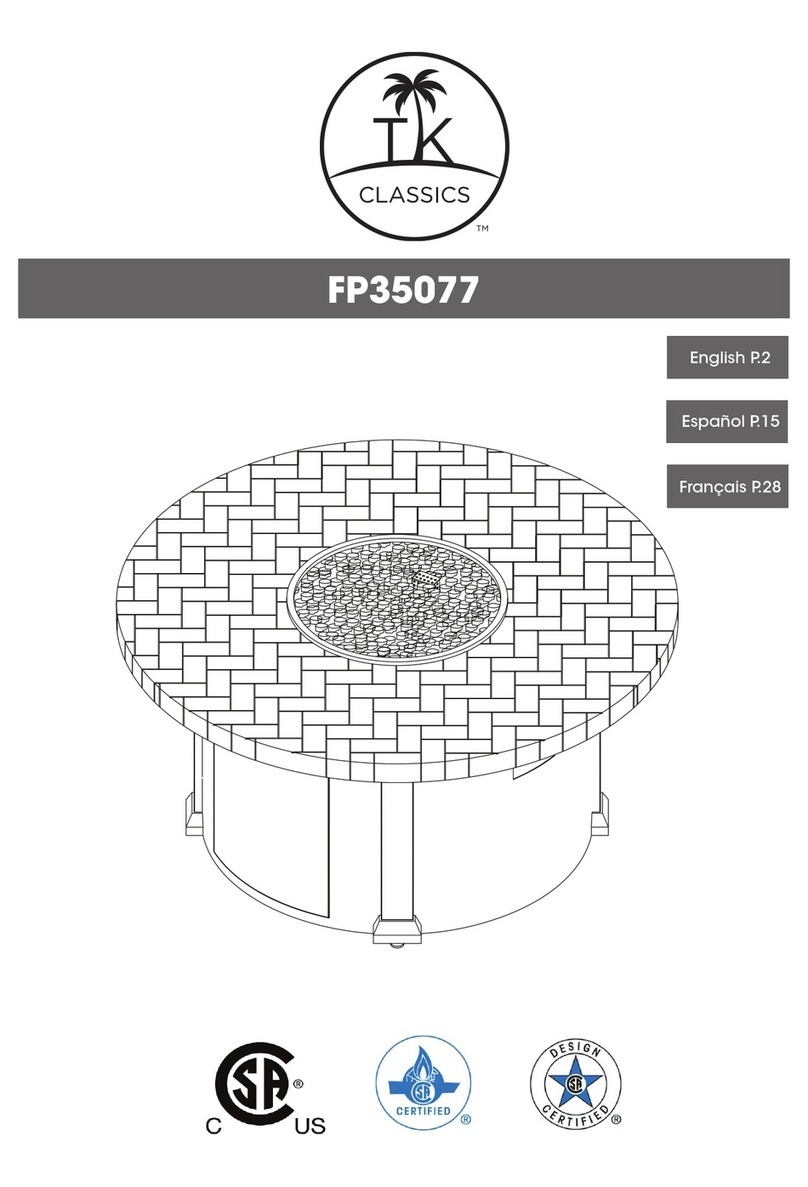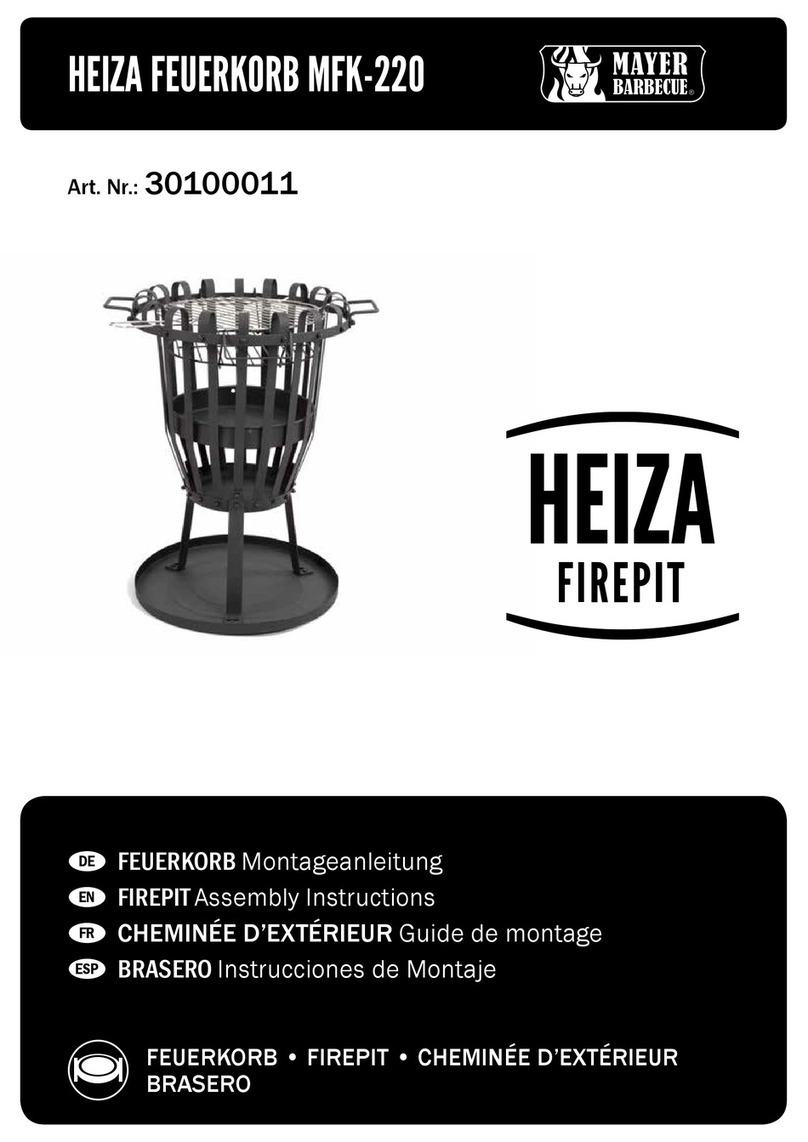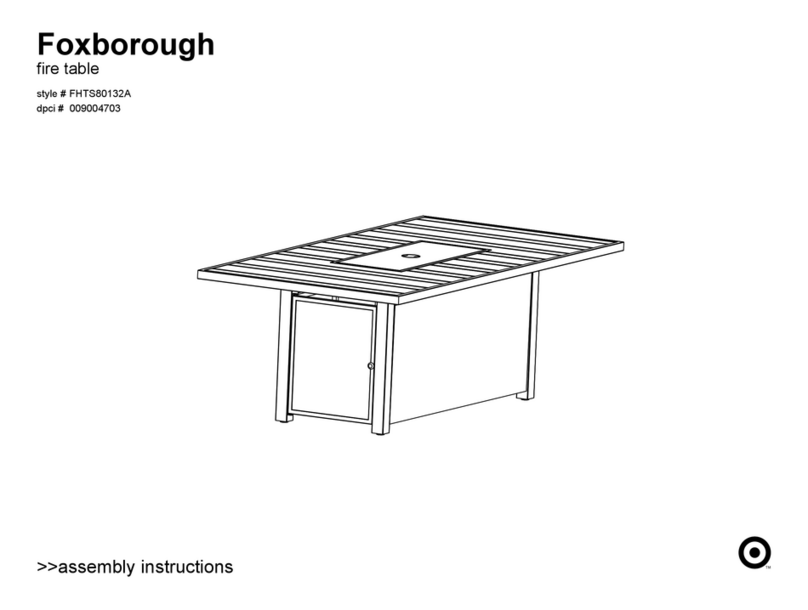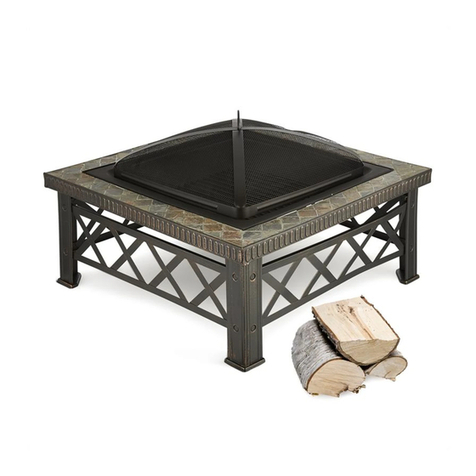PRISM+ Hardscapes Moderno 5 Instruction manual

INSTALLATION, OPERATION &
MAINTENANCE MANUAL
For model: PH-Ignite, 12VAC Auto Burner Ignition System

WARNING! THIS APPLIANCE IS FOR OUTDOOR USE ONLY!
This manual should remain with the homeowner or parties responsible for operation.
Table of Contents
SECTION 1: Safety Instructions
SECTION 2: General Description
2.1 System Overview
2.2 Product Dimensions
2.3 Gas & Electric Requirements
2.4 Product Contents
Section 3: Installation Details
3.1 Preparation & Installation
3.2 Gas Orifice
Section 4: Product Setup & Operation
4.1 Initial Setup
4.2 Operation
Section 5: Wiring & Layout Diagram
Section 6: Troubleshooting
Section 7: Warranty
SAVE THESE INSTRUCTIONS. DO NOT DISCARD.

Section 1 Safety Instructions
WARNING
Before installing this product, read and follow all warning notices and instructions provided. Failure to do so
may result in serious injury, property damage and/or death.
For additional free copies of these instructions, visit our website at prismhardscapes.com
DANGER: ELECTRICAL SHOCK OR ELECTROCUTION
This product must be installed by a licensed or certified electrician in accordance with the National Electrical
Code® and applicable local codes and ordinances. In Canada, the Canadian Electrical Code and all applicable
local codes and ordinances must be adhered to. Improper installation will create an electrical hazard, which
could result in injury, property damage, and/or death.
This product is only available for 12-volt AC power. For supply connections, use only an isolating low voltage
power supply with ungrounded output evaluated and listed by a nationally recognized testing laboratory.
This product must be installed and serviced by a contractor or qualified installer who is licensed and/or
certified within the jurisdiction where the product will reside. In the event no such state or local
requirement exists, the installer or maintainer must be a qualified professional with sufficient experience
in installation and maintenance of gas appliances. Prior to installation, read and follow all warning
notices and instructions that provided with this product. Failure to do so may result in property damage,
personal injury, and/or death. Improper installation and/or operation may result in exposure to carbon
monoxide and flue gases which can cause serious injury, property damage, and/or death. For
installations in the vicinity of occupied/living areas, Prism Hardscapes strongly recommends installation
of carbon monoxide detectors within reach of this appliance and in any adjacent occupied spaces.
Improper installation and/or operation will void warranty.
Do not store or use gasoline or other flammable vapors and liquids
within the vicinity of this or any other appliance.
WHAT TO DO IF YOU SMELL GAS
•
Immediately switch off main gas supply.
•
Do not try to light any appliance.
•
Do not touch any electrical switch; do not use any phone near unit
•
Immediately remove yourself from the area, call your gas supplier and follow
their instructions.
•
If you cannot reach your gas supplier, call the fire department.
Installation and service must be performed by a qualified installer, service agency
or gas supplier.

WARNING
This appliance may produce carbon monoxide which has no odor. Using this appliance in an enclosed space
such as a motorhome, camper, car or home may result in death.
Prism Hardscapes utilizes CSA certified components. Installation must conform to local codes, National Fuel
Gas Code ANSI Z223.1/NFPA and/or National Fuel Gas Code.
Appliance should be serviced annually by a professional gas technician certified in the United States by the
National Fireplace Institute (NFI). Any parts that require replacement should be replaced only by a certified
service professional using parts recommended by manufacturer.
Do not alter any component or design of this unit as it may alter the operation.
This fire feature is not intended for cooking. Do not place anything on or in fire feature.
Never use fire feature in windy conditions.
Do not reach across or touch hot surfaces or open flames.
Do not ignite fire feature when media (rocks/glass) is wet. Doing so may cause media to crack and burst.
It is important to inspect your fire feature before every use. Make sure there are no obstructions or
combustible materials on or near unit.
Wipe down surface of unit before every use and immediately clean any spills or messes on or around unit.
Consistently check hoses and fittings for cracks, abrasions and leaks (at least once a month).
Always keep children and animals away from fire feature.
Use a designated fire pit or barbecue cover when not in use.
If burner goes out, immediately turn off gas and wait several minutes to ensure that there is no residual raw
gas. Then turn gas back on and re-light burner.
Inspect unit and components prior to initial start-up and after each service by a certified technician.
CALIFORNIA PROPOSITION 65
This product can expose you to Chromium, which is known in the state of California
to cause cancer, birth defects or other reproductive harm.
(for more information, go to: www.p65warnings.ca.gov)

Section 2 General Description
2.1 SYSTEM OVERVIEW
•Electronic Ignition for fast & convenient fire feature lighting
•Electronic flame sensing for instant flame safety & monitoring
•This product is designed and assembled to comply with ANSI Z21-97
•Operates on 12 Volts AC and complies with NEC 2014 Article 680
•This product may be installed within 5 feet of pool water
•Operates with a hot surface ignition system with robust construction and reliable ignition source
•Potted electronics for moisture resistance and reliable operation
•Pilot burner wires are made of high temperature material to withstand temperatures up to 450
degrees centigrade (UL 5335/5107)
•Internal electronics are CSA Certified to Z 21.20-2014
•Operating temperatures are between -20 F to 185 F
•Weatherproof stainless-steel construction with waterproof connectors
2.2 PRODUCT DIMENSIONS

2.3 GAS & ELECTRONIC REQUIREMENTS
INPUT VOLTAGE: 120 VAC/60 HZ to transformer
OUTPUT VOLTAGE (transformer to appliance): 12 VAV/60 HZ
GAS TYPE: Natural Gas Propane Gas
GAS PRESS 7 inches Water Column 11 inches Water Column
GAS INPUT FLOW 85,000 BTU/HR 85,000 BTU/HR
RECOMMENDED CLEARANCES TO COMBUSTIBLE SURFACES: SIDES: 4 FT TOP: 6 FT
Note: Check with your gas supplier to verify gas flows and pressures available at the location of your
installation. In many cases utility companies will install larger meters at no charge to accommodate
larger flows.
WARNING
THIS PRODUCT OPERATES WITH 12 AC INPUT
DO NOT ATTEMPT TO CONNECT 120 VACS DIRECTLY TO THE APPLIANCE FOR IT
MAY CAUSE PERMANENT DAMAGE
2.4 PRODUCT CONTENTS
PART NAME
QTY
BURNER & BURNER PLATE
1
PILOT ASSEMBLY (PILOT BURNER, IGNITOR, SENSOR $ HOOD)
1
IGNITION CONTROL BOX
1
HEAT SHIELD
1
HEAT SHIELD JAM NUT
1
ORIFICE SET (BURNER & PILOT)
1
TRANSFORMER (120VAC/12VAC)
1

Section 3 Installation Detail
3.1PREPARATION
The fire feature will require both gas and electrical power. Make sure gas and electricity is turned off
before installing pipes and wires. Install the control panel and gas piping as shown in Figure 1: Natural
Gas, Figure 2: Propane Gas.
Note: Piping and fire bowl/ fire pit construction is different for natural gas and propane gas. Internal gas
lines must be clean and free from any dirt, debris, or contamination.
1. The gas piping and electrical conduit must be installed underground between the control
panel/gas meter and the fire feature. Please consult with a gas professional for proper gas pipe
and fitting sizing. Using smaller piping over long lengths will result in a diminished flame due to
pressure drop/piping resistance.
2. Maintain good piping practice by keeping pipe length and elbows to a minimum to eliminate
unnecessary pressure drops. IMPORTANT: Corrugated flex gas lines should not be used
underground as permanent piping. Rigid pipe should always be used for permanent installation.
3. The gas piping must be reduced to 3/4″ pipe at the fire feature with the means to shut off the
gas supply from the gas meter.
4. Install a ¾” to 1/2” reducer at the fire feature “stub-out” riser. The gas and electric risers should
not be more that 3” to 4” above the installation surface.
5. Install the 1/2” flare to ½” NPT fitting into the reducer fitting/pipe. You may place a manual shut
off valve between the elbow and the reducer for future maintenance. Test gas piping for leaks
Note: The gas and electrical connection should be located at or near the center of each fire bowl/table.
For the electrical, you will need 2 wires and a ground to the appliance.
6. Install wiring (14 or 16 ga) underground between the control panel and the burner assembly. DO
NOT USE BELL OR SPRINKLER WIRE. Lower gauge wire is not capable of carrying the current
needed to operate the appliance. Follow the wiring diagram in Section 6. The appliance should
be wired to a switch or dry contact on the 120 VAC side of the transformer.
NOTE: A light switch, emergency switch, relay contact, mechanical timer should always be installed on
the 120 VAC side of the transformer in order to operate the fire feature. The 12 VAC side may be wired
as far as 50 feet away from the transformer using 14-gauge wire.
7. Only place your fire feature on a level surface and ensure piping is centered, anchor if not
directly on the ground.
8. Take the 1/2” flex hose (provided) and tighten to the flare fitting from the supply line. Do not
kink or make a tight radius bend on the gas hose as it may restrict the flow of gas.
9. There are several vents and drainage holes in the fire bowl/table which must not be blocked. The
electrical and gas pipe hole is sealed such that water cannot penetrate the coping surface under
the bowl and will flow freely away and out to the edges.

3.2 INSTALLATION
INSTALLATION SHOULD BE DONE BY A QUALIFIED GAS SERVICE PROFESSIONAL.
1. The Burner/pan and control will need to be connected to the gas and electrical lines coming up
from the fire feature. Make sure you have the correct orifices on the pilot and the burner inlet
for the gas you are using. You must use the proper orifices for natural gas or propane gas for
both the pilot burner and the main burner. Refer to Section 3.3 for orifice replacement.
2. Connect the flexible gas hose to the inlet flare fitting on the control box. Using a wrench,
tighten the hose to the fitting to avoid gas leaks. If this fitting is not tightened correctly it will
leak and potentially ignite and can damage the control system.
3. Connect the 12 VAC wires, from the control box, to the electrical wires coming out of the
conduit using wire nuts to secure connections. Link the copper ground wire to the
ground/bonding lug on the control box.
4. Reposition the burner and pan onto the fire feature and turn on the gas to check for leaks.
Installing a control box on a non-Prism Hardscapes fire feature
Be sure to use only approved burners with fire feature as they have been pre-tested and rated
for the input and gas designated on the control box.
1. The burner plate must be cut and fitted for the pilot burner assembly in order for the main
burner to ignite and operate properly.
PILOT CUTOUT
HOLE

2. The main burner must have a flame port directly in front of the pilot for the ignition system
to light the main burner and sense the flame.
3. Take the burner and plate and turn it upside down. Add thread sealer onto the burner pipe
threads with particular attention to the last three threads.
BURNER EDGE
PILOT CUTOUT
HOLE
MOUNTING HOLES
BURNER PORT HOLE
PIPE THREAD SEALER

4. Take the control box and install the heat shield onto the pipe. To do this, thread the brass
pipe nut onto the burner orifice as far down as possible. Place the heat shield over the outlet
pipe of the control box and thread the orifice into the outlet pipe until tight. Use a wrench on
the burner orifice to tighten fully. Align the heat shield such that it fully shades the control
box and tighten the brass pipe nut enough so that the heat shield will not move.
5. Now, take the control box and install it onto the burner pipe, thread until fully tightened.
Align box so that the pilot hole is exposed and accessible to install the pilot assembly.
6. Turn the burner plate right side up and insert pilot assembly into the pan cutout with the
pilot hood slots facing the burner.
7. Align the two mounting holes over the two holes on the burner plate. Using the self-drilling
screws, secure the pilot burner assembly onto the burner plate.

8. Turn the burner back over exposing the control box and pilot assembly wires. Refer to the
image below, this is what your unit should look like this far.
9. Take the flexible stainless steel pilot hose and secure onto the 1/4” flare fitting at the control
box. Make sure it is tight but do not over tighten as it may strip the threads.
10. Take each half of the 4-pin connector and join the two halves together. Push the connectors
firmly until the latch clicks into place.
11. Take the ½” stainless steel hose and secure onto the ½” gas flare fitting on the control box.
The other end should be connected and tightened onto the ½” flare fitting located at the
supply pipe stub-out riser.
12. Place the burner and plate back into position on the fire feature.
13. Turn on the gas and test for operation. It may take a few tries to purge all the air from the gas
line.
14. Once the burner lights, turn off the unit and let cool.

3.3 REPLACING GAS ORIFICE
Locate the two orifices, one is at the base of the pilot burner and the other is at the end of the main
burner (see pictures below). Each orifice is meant for a specific type of fuel; Natural Gas or Liquid
Propane.
BURNER ORIFICE
PILOT ORIFICE
BURNER ORIFICE
NATURAL GAS
BURNER ORIFICE
PROPANE GAS
PILOT ORIFICE

1. Turn off the electric and gas supply to the fire feature.
2. Remove any fire media that is on top of the burner plate.
3. Unscrew the 2 screws holding the pilot assembly in place.
4. Carefully pick up the burner plate and turn upside down.
5. Unplug the 4-pin connector from the control box to the pilot assembly.
6. Disconnect the flexible pilot gas hose from the control box.
7. From the top of the burner plate, gently pull up the pilot assembly and remove from the plate.
Replacing the Pilot Orifice
Pilot Head Assembly
1. Disconnect the flexible gas hose from the pilot. Be careful not to put pressure on the ceramic
flame sensor; damaging the flame sensor will render the flame sensor inoperable.
2. Remove the flare fitting from the pilot assembly.
3. Remove the pilot orifice from the pilot assembly and replace with the new one.
4. Hand-tighten the orifice until seated. Use wrench to secure but do not over-tighten.
5. Hand-tighten the flare fitting until snug.
6. Take flexible pilot hose and tighten onto the flare fitting. Once snug, use wrench to tighten
the hose fitting.
Replacing the Burner Orifice
PILOT HOOD
PILOT SENSOR
GROUND WIRE
PILOT ORIFICE
PILOT GAS HOSE
FLARE FITTING
PILOT PLATE

1. Turn off the electric and gas supply to the fire feature.
2. Remove any fire media that is on top of the burner plate.
3. Unscrew the 2 screws holding the pilot assembly in place.
4. Carefully pick up the burner plate and turn it upside down.
5. Make sure pilot assembly has been disconnected and removed.
6. Using a wrench, unscrew the burner orifice from the pipe, keep a hand under the control box
so that it doesn’t fall when the orifice disengages.
7. Place the removed assembly on a flat surface and hold firmly.
8. Using a wrench, remove burner orifice from the control box outlet pipe. Be careful of the
heat shield as it will come off once the orifice is removed.
ORIFICE
JAM NUT
HEAT SHIELD
OUTLET PIPE
PILOT HOSE

9. Remove the jam nut from the orifice.
7. Place nut onto the new orifice and thread it until it will no longer turn.
8. Place pipe thread sealer onto the new orifice threads covering, be sure to cover the last three
threads well.
9. Place the heat shield over the control box outlet pipe and begin threading the orifice into
place. Tighten with a wrench until secure.
10. Once the orifice is tightened, there will be several threads left between the jam nut and the
heat shield. With the wrench, tighten the jam nut until the heat shield is firmly secured into
place.

12. Place pipe thread sealer onto the burner pipe.
13. Place the control box outlet onto the burner pipe and turn clockwise until tight.
14. Align the control box to where the pilot hole is accessible.
PILOT HOLE

Final Burner and Pilot Assembly
1. Turn the burner plate right side up. Insert the pilot connector and hose through the pilot hole
on the plate. Make sure the slotted side of the pilot hood is facing the burner.
2. Align the pilot plate mounting holes and secure the two mounting screws through the pilot
plate to the burner plate.
3. Turn the burner plate upside down. Take the 4-pin connector from the pilot and connect it to
the matching 4 pin connector from the control box. Push firmly to make sure it clicks into place.
MOUNTING SCREWS

4. Take the flexible stainless steel pilot hose and connect it to the control box fitting. Secure with
wrench but be careful not to over-tighten as it may damage the brass thread.
5. Attach the gas supply flex hose to the control box gas inlet fitting and secure with wrench.
15. Place the burner and plate back into position on the fire feature.
16. Turn on the gas and test for operation. It may take a few tries to purge all the air from the gas
line.
17. Once the burner lights, turn off the unit and let cool.

Section 4 Product Setup & Operation
4.1 SETUP
1. Carefully spread the fire media evenly onto the burner plate, do not overfill. You may cover the
burner until it is not visible but do not cover the pilot hood, see image below.
2. Perform a burn test (see section 4.2), if there are areas on the burner that lack flame it may be
a result of too much media.
3. Turn off the system, allow time to cool before clearing the media where the flames were
absent and repeat step 2
4.2 OPERATION
Turn on the power switch to the unit. After 3 seconds, the igniter will begin to glow red. The pilot burner
will then ignite and stay lit for 6 to 8 seconds until the main burner produces flames. Once the burner is
lit, the ignitor will turn off and the flame sensor will keep the flames going.
Note: Wind gusts may displace the flame away from the flame sensor causing a 7 second system to shut
down and re-start the firing sequence. The system will try 3 times to light. If it still fails to ignite, it will
lock out (turn off completely) and will need to be reset by turning the power off and then on again.
Do not operate in rainy conditions as the flame will not operate optimally.
Always turn off your system when fire feature is not in use and never leave the unattended.
It is recommended to cover your fire feature if it will be out of use for a long period of time.

Section 6 Wiring Layout & Diagrams
This manual suits for next models
1
Table of contents
Popular Outdoor Fireplace manuals by other brands
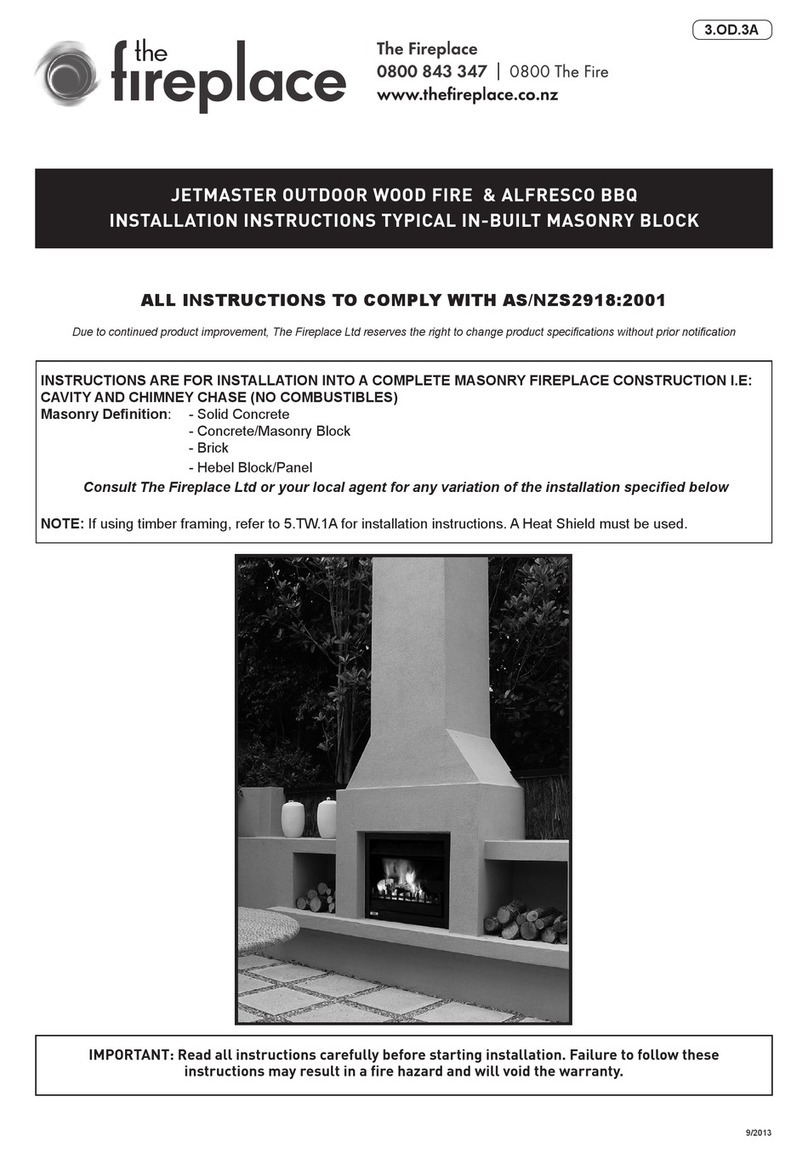
The Fireplace
The Fireplace JETMASTER 700 D installation instructions

Superior
Superior VRE4543EN Installation and operation instructions
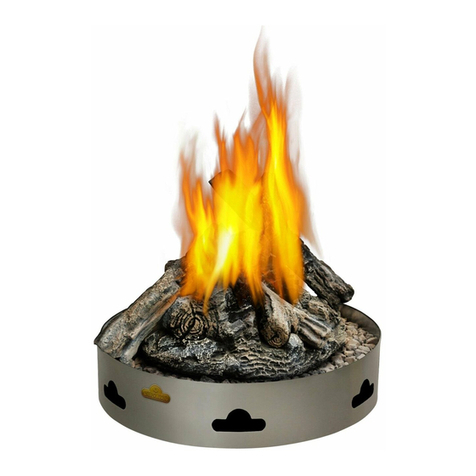
Napoleon
Napoleon PATIOFLAME GPFN Installation and operation instructions

Endless Summer
Endless Summer Dakota GAD19101ES owner's manual

Vermont Castings
Vermont Castings ODGSR36A Homeowner's installation and operating manual

FEUERHAND
FEUERHAND PYRON user manual
